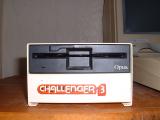
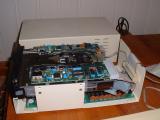
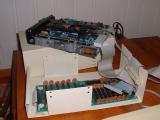
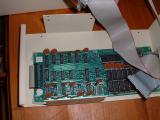
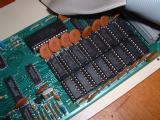
| [ Main index | Pictures of BBC computer related stuff | BBC add-on hardware | ] |
Pictures are mostly 1600x1200 pixels / ca. 350 KB.
The is a very nice drive + diskinterface, which connects to the BBC via the 1MHz port. The disk interface is in the drive box, together with 256K or 512K RAM. The RAM is used as 1 (in case of 256K) or 2 (in case of 512K) ramdisks, and to keep PAGE at 0E00...
The drive itself is a mitsubishi 80 track (from late 1985, mitsubishi seems to have switched from the vertical levers like those on full-height drives, to rotating levers, in 1985).
The automatic 40/80 track sensing makes for hasslefree reading and writing of 40 and 80 track disks.
This was originally a 256K version, with the 8 NEC D41256C RAM chips (256Kx1) installed. I recently added Siemens HYB 41256-12s, but they didn't work correctly (one out of every 256 bits did not refresh (are there refresh differences in 256Kx1 chips?). Here's a test program that accesses the RAM (the second 256K, as pg1=4 to 7) directly:
10VDU 15 20FOR pg1=4 TO 7 30FOR pg=0 TO 255 40PRINT"Page ";pg1, pg 50?&FCFF=pg 60?&FCFE=pg1 70FOR I%=0 TO 255 80?(&FD00+I%)=23 90NEXT 100FOR I%=0 TO 255 110IF (?(&FD00+I%)<>23) PRINT "ERROR ";~pg1*65536+pg*256+I%,?(&FD00+I%):g=GET 120NEXT 130NEXT 140NEXT
In case of an error, the address + value is printed, and the program waits for a keypress to continue.
Note that you cannot rewrite this in machine code without care: there needs to be a reasonable delay between writing and reading the same byte (i.e. more than the maximal refresh time; 0.01s will probably be enough). A quick test is to save a screen with a few lines drawn on it, to drive 5, reload it. If the lines are chopped up, the RAM chips are faulty.
I then got some Sharp LH 21256-12s and they work fine. The speed (-12 = 120ns) probably doesn't matter. You can get these ICs from discarded 286 PCs...
| To email me, go to this page |
Last modified: Fri Nov 2 01:06:11 CET 2012